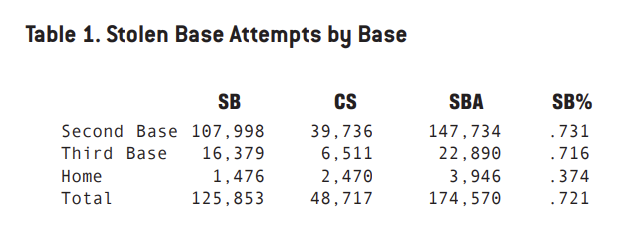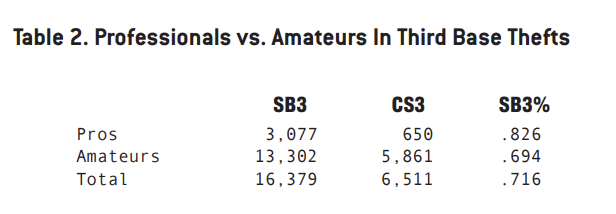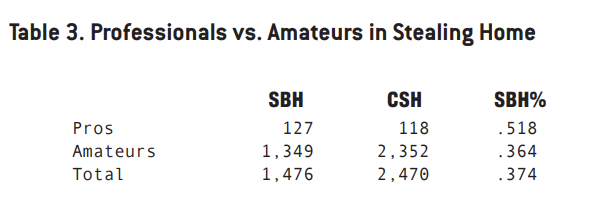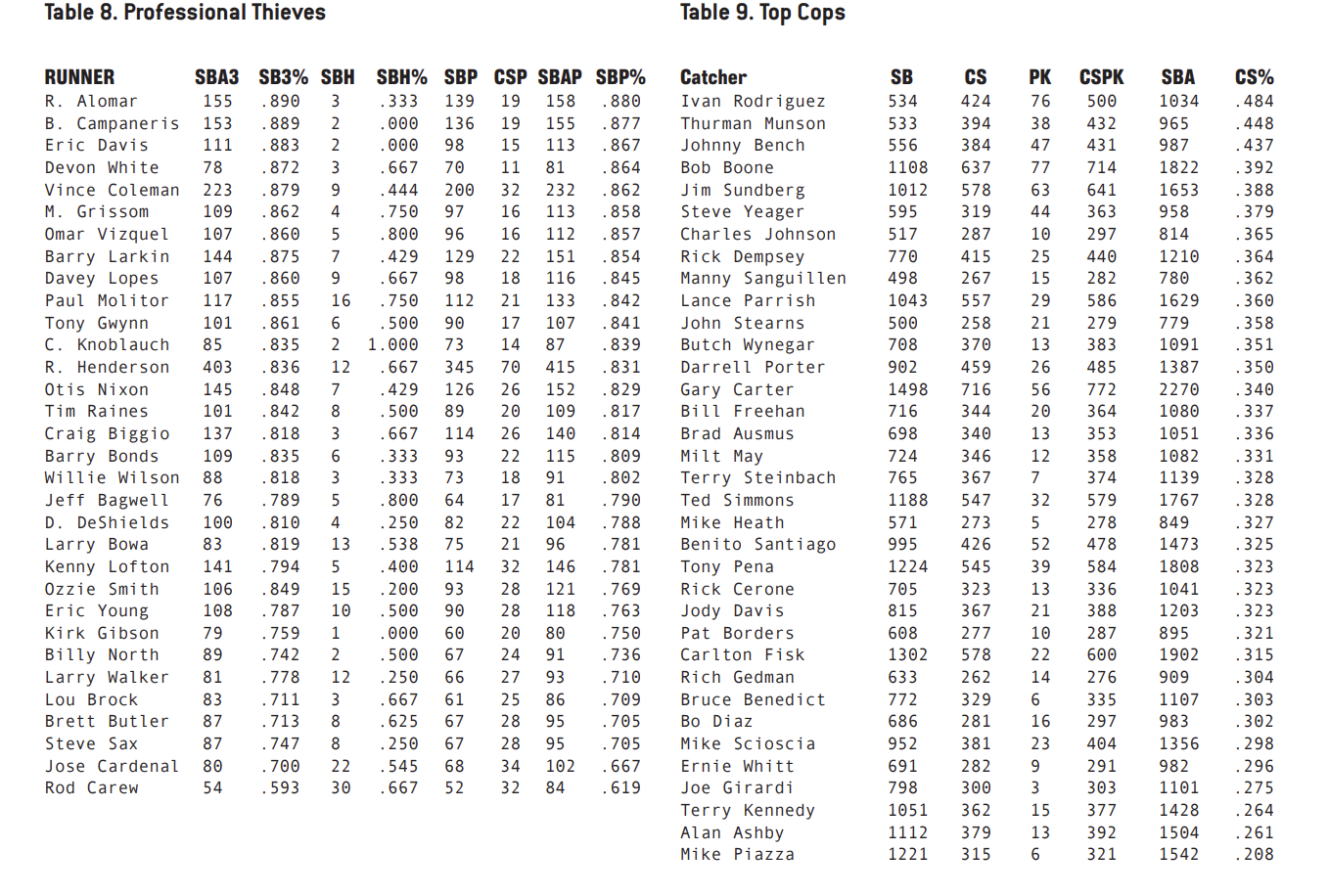Professional Thieves vs. the Constabulary
This article was written by Chuck Rosciam
This article was published in 2004 Baseball Research Journal
Who are the professional thieves (base stealers) and who are the top cops (catchers)? How do we differentiate professional from amateur? Do arrests by the constabulary (caught stealing by the catcher) measure greatness in a backstop or is it pure ineptness by the thief?
An analysis of Retrosheet data from 1963 to 2004 was performed to answer these and other questions. During the data period there were 174,570 stolen base attempts (SBA) involving 61,131 runner-catcher match-ups. The breakdown of these SBA’s is:
To separate the professional thief from the amateur, all 3,223 runners’ efforts were categorized by their success or failure at each base. Because the success rate at stealing third or home was lower than the theft rate of second, the top 1% of the runners who attempted third or home were selected out and designated as the professional thieves. As expected, the usual suspects (Henderson, Brock, Coleman, Carew, and Raines) made the list of 32. (See Table 8).
The success rate for all runners attempting to steal third base was 71.6%. Of the 32 professional thieves, only four had a worse rate than the MLB average. These gone-to-the-well-too-often guys were Lou Brock, Brett Butler, Jose Cardenal, and Rod Carew. The player that had the best success-rate at stealing third was Roberto Alomar with 89.0% (138 out of 155 attempts). The worst professional was Rod Carew with 59.3% (32 out of 54 tries). The most attempts were tried by Rickey Henderson (403), and the fewest attempts by a professional goes to Rod Carew (54).
How well did our professionals do compared to the 3,191 amateurs? Even though our professionals represented only 1% of all thieves, they accounted for 18.8% of all successful thefts of third base. Their success rate was 13% better than the amateurs as the following table shows.
The master thieves among the professionals were the ones that tried a theft of home. In the data sample there were 1,413 different thieves that attempted this feat. Only 794 were successful at least once or slightly more than half (56.2%). Among our 32 professionals, nearly a third (10) had an average worse than the whole sample (37.4%). The most attempts were tried by Rod Carew (30), and the fewest attempts by our professionals was 1 by Kirk Gibson.
The most successful thefts of home were 20 by Rod Carew. However, this is far short of the MLB record of 54 by Ty Cobb. In fact, Carew’s total is only good for ninth on the all-time list.
Again, we can compare the professionals against the amateurs when it comes to racing home. The elite 1% captured 8.6% of all of the steals of home, which was only half as good as their third base nabbing. The pros’ success rate was 15% better than the amateurs.
Now let’s turn to the constabulary, the ones whose job it is to catch those pesty base stealers. In our data sample there were 630 different catchers. To determine who were the top cops a criteria of a minimum of 275 nabbed thieves was established. For this study caught stealing also included pickoffs of the runners when the catcher threw to the base. The criteria represented 5.5% of the constabulary, they made 29.9% of the arrests.
Table 4. Top Cops vs. Beat Cops at Nabbing Thieves
|
CS |
SBA |
CS% |
|
|
Top Cops |
14,580 |
43,581 |
.335 |
|
Beat Cops |
34,137 |
130,989 |
.261 |
|
Total |
48,717 |
174,570 |
.279 |
Did the high success rate of stopping crime on the bases detour our thieves? No. The top cops were involved in 25% of all of the attempts at thievery. Who caught the most? That honor belongs to Gary Carter, who nabbed 772 runners. Who among our top cops had the fewest? That was Rich Gedman with 276. The best percentage of catching base stealers is owned by Ivan Rodriguez (48.4%), and the worst record is held by Mike Piazza (20.8%).
How did our top cops fair at the various bases? The following table provides the answer (pickoffs shown but not included in the totals).
Table 5. Top Cops’ Record at the Bases
|
|
CS |
SBA |
CS% |
|
1st Base (PK) |
424 |
— |
|
|
Second Base |
12,354 |
38,156 |
.324 |
|
Third Base |
1,370 |
3,888 |
.352 |
|
Home |
432 |
646 |
.669 |
|
Total |
14,156 |
42,690 |
.332 |
The next logical step is a side-by-side comparison of the professional thieves’ success rate at the various bases as compared to the top cops. [It should be remembered that the thieves’ record is against all catchers and that the top cops’ record is against all thieves.] Table 6 entries for the catchers have been “flipped over” (SB rate versus CS rate) to provide a quick illustration without having to do the math.
Table 6. Professional Thieves vs. Top Cops
| Thieves SB% | Cops SB% | Diff. | |
| Second base | .842 | .676 | +.166 |
| Third base | .826 | .648 | +.178 |
| Home | .518 | .331 | +.187 |
| Total | .817 | .668 | +.149 |
On the average, the top cops are 14.9% better at catching all thieves than are the professional thieves at stealing against all cops. It appears that, generally, crime doesn’t pay.
The last, and obvious, question is how did the 32 professional thieves do against the 35 top cops in a head-to-head match? The answer will have to be given in another article. But, to round out this study I selected one matchup out of the thousands in the data. Taking the Number One Professional Thief (Roberto Alomar) against the Number One Top Cop (Ivan Rodriguez), the results of the matchup yield:
Table 7. Alomar vs. Rodriguez
| SB | CS | SB% | |
| Second base | 8 | 4 | .667 |
| Third base | 3 | 3 | .500 |
| Home | 0 | 0 | .000 |
| Total | 11 | 7 | .611 |
Although the sample is very small, one can opine that the top cop (Rodriguez) got the better of the professional thief (Alomar) in their 18 confrontations. However, Alomar was successful 61.1% of the time compared to all other runners who only managed a theft 51.6% of the time against Rodriguez. But, the professional thief met his nemesis in Rodriguez because Alomar was used to stealing 80.9% of his attempts. His success rate dropped 20% which seems to say, once again, that crime doesn’t pay when a runner is up against the top cops.






